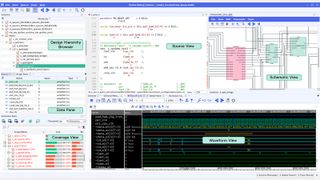Months after completing a major project, leading Chinese chip development software firm cuts half of workforce: Report
Reportedly due to market headwinds

X-Epic, a leading Chinese chip design software developer, is cutting its workforce by up to 50%, reports the South China Morning Post. Just a few months ago the company completed a major project: it developed an electronic design automation (EDA) suite that covers a variety of aspects of chip design that works on processors made in China, a major breakthrough for Tianxia's semiconductor industry. However, X-Epic has to reduce headcount amid 'market headwinds.'
The job cuts, which started this week, affect multiple departments, notably the core research and development unit, according to sources familiar with the situation, who preferred to remain anonymous as the deal is a private matter. The company did not respond to South China Morning Post's requests for comment.
The reason for layoffs is said to be market downturn, though keeping in mind that China's market of EDA tools is dominated by foreign companies, notably Ansys, Cadence, Siemens EDA (former Mentor Graphics), and Synopsys, the competition is fierce and American companies control about 70% of China's EDA market.
X-Epic was established by Wang Libin, a former engineer from Cadence Design Systems. The company grew quickly, employing about 400 people across various cities in China, including Nanjing, Beijing, Shanghai, Chengdu, and Shenzhen, as of March 2023. Investors in X-Epic include HongShan (formerly Sequoia Capital China), Matrix Partners China, and China Information and Communication Technology Group. In May, the Nanjing government listed X-Epic as a favored innovative startup, highlighting its potential in the local EDA sector. As of March 2023, it had reportedly raised $121.7 million in funding. For Chinese EDA firms it is not uncommon to get funds from authorities.
The reliance on foreign EDA software remains a significant weakness in China's semiconductor industry, alongside challenges in wafer fab tools, such as lithography machines.
Major Chinese EDA firms, including X-Epic and Empyrean Technology, are striving to develop EDA tools that can be used to design chips to be made on advanced nodes, such as 14nm/16nm and below. U.S. sanctions prohibit to import advanced EDA software to Chinese entities without an export license that is reviewed with a presumption of denial, so X-Epic and Empyrean will have to come up with appropriate tools rather sooner than later as China strives to semiconductor self-sufficiency, which is why Empyrean reportedly getting huge cash influxes.
Despite all odds, the value of China's EDA market is projected to grow. It is expected to reach ¥18.5 billion ($2.55 billion) next year, up from ¥9.3 billion ($1.281 billion) in 2020, which indicates a strong potential for future development despite current setbacks, according to SCMP. Yet, for now, Chinese EDA companies have to cut their headcount and get money from authorities to remain afloat.
Stay On the Cutting Edge: Get the Tom's Hardware Newsletter
Get Tom's Hardware's best news and in-depth reviews, straight to your inbox.

Anton Shilov is a contributing writer at Tom’s Hardware. Over the past couple of decades, he has covered everything from CPUs and GPUs to supercomputers and from modern process technologies and latest fab tools to high-tech industry trends.
-
MacZ24 200 employees lose their job from a 400 employees company founded in 2020 ?Reply
It is obvious China is crashing, for sure.
I mean, it's like 0.0000142% of the population. -
Notton This is business as usual.Reply
Once a project is complete, the hard part is done.
You don't need 100% of the workforce to maintain, patch, and build-on things.
In fact, you don't even need the lead designer, it seems.
Just look at the portfolio of Jim Keller and Raja Koduri for an example.
Most Popular






